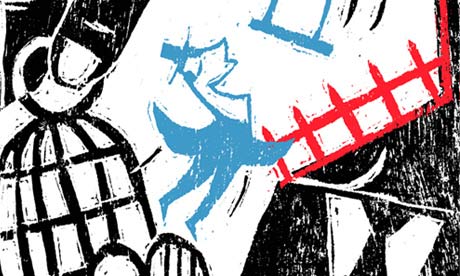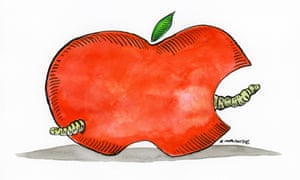This bastardised libertarianism makes 'freedom' an instrument of oppression
It's the disguise used by those who wish to exploit without restraint, denying the need for the state to protect the 99%

Illustration by Daniel Pudles
Freedom: who could object? Yet this word is now used to justify a
thousand forms of exploitation. Throughout the rightwing press and
blogosphere, among thinktanks and governments, the word excuses every
assault on the lives of the poor, every form of inequality and intrusion
to which the 1% subject us. How did libertarianism, once a noble
impulse, become synonymous with injustice?
In the name of freedom –
freedom from regulation – the banks were permitted to wreck the
economy. In the name of freedom, taxes for the super-rich are cut. In
the name of freedom, companies lobby to drop the minimum wage and raise
working hours. In the same cause, US insurers lobby Congress to thwart
effective public healthcare; the government rips up our planning laws;
big business trashes the biosphere. This is the freedom of the powerful
to exploit the weak, the rich to exploit the poor.
Rightwing
libertarianism recognises few legitimate constraints on the power to
act, regardless of the impact on the lives of others. In the UK it is
forcefully promoted by groups like the
TaxPayers' Alliance, the
Adam Smith Institute, the
Institute of Economic Affairs, and
Policy Exchange. Their concept of freedom looks to me like nothing but a justification for greed.
So
why have we been been so slow to challenge this concept of liberty? I
believe that one of the reasons is as follows. The great political
conflict of our age – between neocons and the millionaires and
corporations they support on one side, and social justice campaigners
and environmentalists on the other – has been mischaracterised as a
clash between negative and positive freedoms. These freedoms were most
clearly defined by Isaiah Berlin in his essay of 1958,
Two Concepts of Liberty.
It is a work of beauty: reading it is like listening to a gloriously
crafted piece of music. I will try not to mangle it too badly.
Put
briefly and crudely, negative freedom is the freedom to be or to act
without interference from other people. Positive freedom is freedom from
inhibition: it's the power gained by transcending social or
psychological constraints. Berlin explained how positive freedom had
been abused by tyrannies, particularly by the Soviet Union. It portrayed
its brutal governance as the empowerment of the people, who could
achieve a higher freedom by subordinating themselves to a collective
single will.
Rightwing libertarians claim that greens and social
justice campaigners are closet communists trying to resurrect Soviet
conceptions of positive freedom. In reality, the battle mostly consists
of a clash between negative freedoms.
As Berlin noted: "No man's
activity is so completely private as never to obstruct the lives of
others in any way. 'Freedom for the pike is death for the minnows'." So,
he argued, some people's freedom must sometimes be curtailed "to secure
the freedom of others". In other words, your freedom to swing your fist
ends where my nose begins. The negative freedom not to have our noses
punched is the freedom that green and social justice campaigns,
exemplified by the Occupy movement, exist to defend.
Berlin also
shows that freedom can intrude on other values, such as justice,
equality or human happiness. "If the liberty of myself or my class or
nation depends on the misery of a number of other human beings, the
system which promotes this is unjust and immoral." It follows that the
state should impose legal restraints on freedoms that interfere with
other people's freedoms – or on freedoms which conflict with justice and
humanity.
These conflicts of negative freedom were summarised in
one of the greatest poems of the 19th century, which could be seen as
the founding document of British environmentalism. In
The Fallen Elm,
John Clare describes the felling of the tree he loved, presumably by
his landlord, that grew beside his home. "Self-interest saw thee stand
in freedom's ways / So thy old shadow must a tyrant be. / Thou'st heard
the knave, abusing those in power, / Bawl freedom loud and then oppress
the free."
The landlord was exercising his freedom to cut the tree
down. In doing so, he was intruding on Clare's freedom to delight in
the tree, whose existence enhanced his life. The landlord justifies this
destruction by characterising the tree as an impediment to freedom –
his freedom, which he conflates with the general liberty of humankind.
Without the involvement of the state (which today might take the form of
a tree preservation order) the powerful man could trample the pleasures
of the powerless man. Clare then compares the felling of the
tree with further intrusions on his liberty. "Such was thy ruin,
music-making elm; / The right of freedom was to injure thine: / As thou
wert served, so would they overwhelm / In freedom's name the little that
is mine."
But rightwing libertarians do not recognise this
conflict. They speak, like Clare's landlord, as if the same freedom
affects everybody in the same way. They assert their freedom to pollute,
exploit, even – among the gun nuts – to kill, as if these were
fundamental human rights. They characterise any attempt to restrain them
as tyranny. They refuse to see that there is a clash between the
freedom of the pike and the freedom of the minnow.
Last week, on an internet radio channel called
The Fifth Column, I debated climate change with Claire Fox of the
Institute of Ideas,
one of the rightwing libertarian groups that rose from the ashes of the
Revolutionary Communist party. Fox is a feared interrogator on the BBC
show
The Moral Maze.
Yet when I asked her a simple question – "do you accept that some
people's freedoms intrude upon other people's freedoms?" – I saw an
ideology shatter like a windscreen. I used the example of a Romanian
lead-smelting plant I had visited in 2000, whose freedom to pollute is
shortening the lives of its neighbours. Surely the plant should be
regulated in order to enhance the negative freedoms – freedom from
pollution, freedom from poisoning – of its neighbours? She tried several
times to answer it, but nothing coherent emerged which would not send
her crashing through the mirror of her philosophy.
Modern
libertarianism is the disguise adopted by those who wish to exploit
without restraint. It pretends that only the state intrudes on our
liberties. It ignores the role of banks, corporations and the rich in
making us less free. It denies the need for the state to curb them in
order to protect the freedoms of weaker people. This bastardised,
one-eyed philosophy is a con trick, whose promoters attempt to wrongfoot
justice by pitching it against liberty. By this means they have turned
"freedom" into an instrument of oppression.






